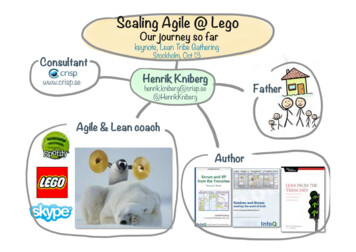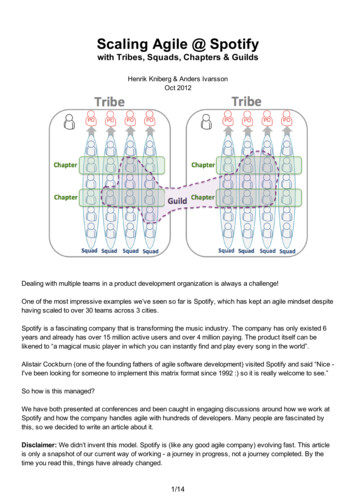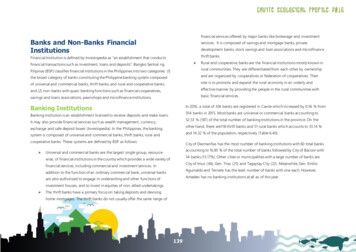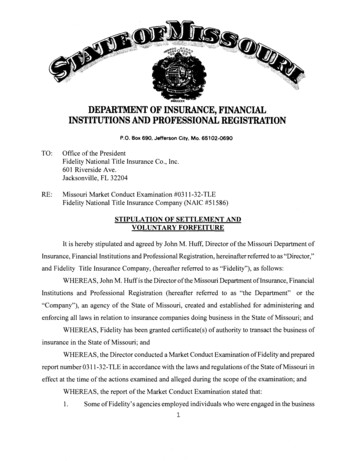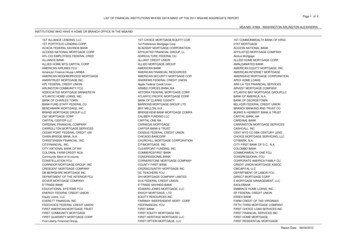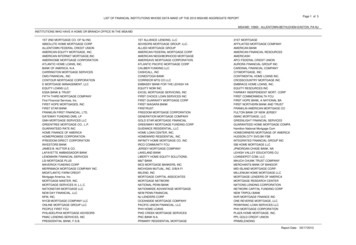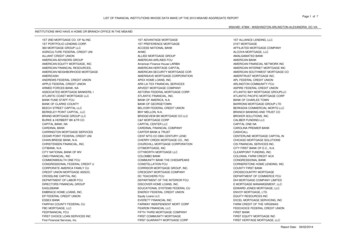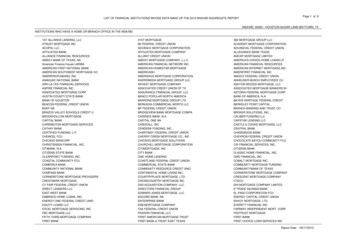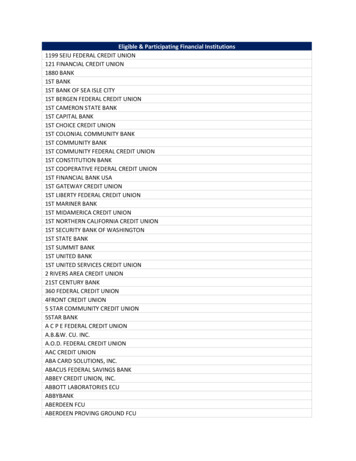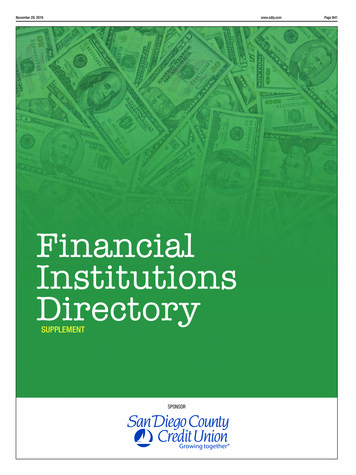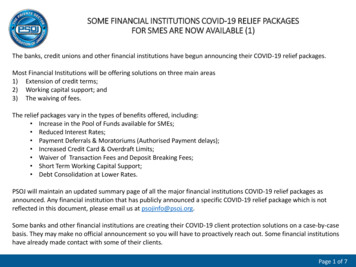
Transcription
Scaling agile atfinancial institutionsLessons fromthe trenches
Contents1Agile approaches to meeting new challenges2Keys to scaling agile339Governance and executionGovernance strategyExecution strategy12Adapting agile
Agile approaches to meetingnew challengesMany large financial services companies face mounting pressure from new, nontraditional competitors. The most disruptiveof these newcomers develop and launch multiple innovations, identify the winners, and then grow at speeds generally hardto match by major institutions.Relative to waterfall development approaches, agile has demonstrated its merits and can accelerate speed-to-market,enhance quality, and increase flexibility while reducing costs and complexity. Various agile methods employ variousapproaches to implementation, but share the following characteristics: Delivering tested software in short, specifically timed iterations Accepting and even encouraging changes in requirements between iterations Mandating client involvement during each iterationHowever, agile methods that work for start-ups, digital design agencies, and mobile app developers do not directlyscale to the purposes of large organizations developing complex products. Those methods require significant changesto meet the needs of large institutions with their legacy systems, external partners, massive footprints, and extensivecompliance requirements.Lessons learnedDeloitte has assisted a number of major financial institutions in deploying agile at scale and has identified a number ofleading practices from the successes of its clients. These projects, among the first of their kind, aim to bring innovativeproducts to market at speed, simultaneously, across multiple locations. Challenges have included regulatory demands,external-system interfaces, documentation needs, and project size, with the latter involving as many as six dozen teamsand 500 individuals.This paper, prepared for chief information officers, key IT program leaders, and other transformationalstakeholders, begins with observations on scaling agile and then moves to the lessons learned in these projects.Each section closes with a brief “Case in point” illustrating how project teams addressed the issue.This paper assumes basic familiarity with agile development concepts and terminology. For further information, alsosee the Deloitte paper Don’t fear change, embrace it: Advancing the case for agile methods in systems integration.1Don’t fear change, embrace it: Advancing the case for agile methods in systems integration, Deloitte Development LLC., ie/Documents/Technology/methods in systems integration.pdf1Scaling agile at financial institutions Lessons from the trenches1
Keys to scaling agileTraditional agile is designed for small teams working on well-defined problems over short periods. Scaling agile to projectswith dozens of teams working on complex products over multiyear horizons clearly presents challenges.Therefore, in order to scale agile to the needs of a large organization, the following are critical:1. Use multiyear road maps: Initiatives in large organizations often involve multiple projects with long-time horizons. Agileimplementations for such initiatives should conform to a long-term road map while maintaining basic principles of agile.2. Strengthen governance structures: Large-scale implementations involve multiple scrum teams from disparate functionsunder different leaders, often in dispersed locations. In scaling agile, additional roles should be established to facilitatecommunication and resolve conflicts.3. Address cross-team dependencies: Often a team requires completed components from another team beforeproceeding further. Such cross-team dependencies create the need for additional coordination when planningupcoming iterations.4. Consolidate reporting and tracking: In traditional agile, progress can be tracked via burn-down charts or other reportsfrom agile tools, such as Rally or VersionOne. In large-scale agile, team burn-down rates should be combined and fittedinto the project-level plans to report overall progress.5. Increase end-to-end quality assurance: Traditional agile relies on functional and unit testing within sprints as wellas other quality control processes. In agile at scale, limits on how frequently code can be integrated create a need fordedicated end-to-end (E2E) testing before releasing code to production.Elements of agile can be adapted to larger financial services organizations, but the organization should also adapt to agile.For example, organizations accustomed to the more sequential waterfall method should prepare to adjust to the highlyinteractive and iterative approaches of agile.Agile can be integrated into existing development processes, and planning, control, and documentation issues can—as thispaper demonstrates—be addressed.2
Governance and executionSuccessful scaling of agile depends mainly on effective governance strategy and sound execution tactics.Effective governance calls for alignment of executive sponsorship across functions, broad agreement on the business case anddesired business value, and acknowledgement of the potential benefits and the limitations of agile. A commitment to datadriven project management fosters the right cadence and atmosphere for the project. That commitment supports governancethat relies on facts rather than opinions, and promotes honesty, openness, and collegiality across the various teams.Governance strategy for agile at scale encompasses the following activities: Agile program structuring Integrated quality management Programmatic backlog management Organizational coexistence Systematic reporting and dashboardsAlso, teams need realistic expectations regarding deliverables, testing, and documentation. Tolerance for the iterative nature ofagile does not come naturally. However, training, mentoring, coaching, pilot projects, and hybrid or gradual adoption can helporganizations develop that tolerance.Sound execution tactics include the following activities: Enhanced scrum roles Development and release management Business process alignmentThe remainder of this document provides an overview of each of these governance and execution activities.Governance strategy: Structuring the agile programCross-team delivery governance constitutes the heart of the agile scaling process. Therefore, sound program structure and clearroles and responsibilities are important.A scaled agile program differs from a traditional agile structure in several ways (see Figure 1).Figure 1: Agile at scale versus traditional agile program structureSteering teamSponsorAgile at scaleBusiness leaderProduct leaderTraditional agilePMOTech leaderInitiative 1Initiative 2CPORepeatinitiative 1organizationalstructureWLADMScrum teamBiz PMO supportBusinessleadersOperationsFinance andaccountingScrum teamARCHDEVQAARCHDEVQAProduct ownerSMProduct ceAnalyticsE2E test managementScaling agile at financial institutions Lessons from the trenches3
Essentially, agile at scale calls for adding some new roles and enhancing traditional roles to promote communication andcoordination. For example, a sponsor and a project management office (PMO) head up the overall project, with input andcoordination with the steering team comprising the business leader, product leader, and technology leader. Each initiativealso requires a workstream lead (WL), an agile delivery manager (ADM), and a chief product owner (CPO), as well asongoing involvement of business stakeholders.Figure 2 further details characteristics of roles in agile at scale.Figure 2: New and modified rolesAgile atat scalescalerolesrolesNew rolesModified traditional rolesCPOChief product owner—Facilitatesproduct decisions and managesprogram-level backlogScrummasterTraditional scrum master duties,also represents scrum team inscrum of scrums (SoS) meetingsWLWorkstream lead—Overallownership of a work streamPOProduct owner—Manages scrumteam backlog, coordinates withother scrum team POsADMAgile delivery manager—Coordinateswith other scrum teams, doesteam-level reportingE2E testManages process flow creation, E2Emanagement test case writing and test executionCase in point #1: New and modified roles for agile at scaleWhile implementing scaled agile within its development teams, a leading credit card issuer modified sometraditional agile roles (e.g., scrum master, PO) and established a few new ones like CPO, WL, and ADM to improveefficiencies in the program. The CPO worked with the business stakeholders to create the epics. The PO detailed the epics, which were reviewed by the tech lead and architect, and broken down by thedevelopment team into tasks to be completed in one sprint cycle. The WL updated the PMO on the progress and status of the initiative. The ADM maintained alignment between the roadmap and development work, coordinated reporting and analysis,and facilitated use of agile tools and end-to-end testing. The PMO addressed controlling to budget and schedule and coordinated the entire project and its partners andstakeholders.4
Governance strategy: Programmatic backlog managementRoadmap planning sets the stage not only for project-level planning and epic story prioritization, but also for sprint-levelbacklog planning and periodic reviews (see Figure 3). As such, roadmap planning is the first step in programmaticbacklog management.Figure 3: Overview of agile planning processRoadmapplanningProject-levelplanning(Epic stories)Epic ting and managing the roadmapBusiness leadership typically outlines the key priorities and milestones in a multiyear productroadmap. Then the team-leads for solutions architecture, platform, IT, and business unitstranslate the roadmap into bodies of work to be delivered quarterly. The following stepsassist in planning a roadmap and translating it into agile delivery items:1. Initiative prioritization: This step considers business criticality, revenue impact, deliverydeadlines, and compliance and legal mandates, and other factors, to develop tiers ofpriority for each initiative. Senior leadership then develops a composite score and rankseach initiative.2. Initiative-level planning sessions: In working sessions, each initiative is divided intolevel 1 and 2 (L1, L2) epic stories. In planning sessions, higher-level sizing on each L2 epicgauges the effort needed from various scrum teams to complete the epic. These sessionsare attended by POs, AOMs, architects, WLs, scrum masters, and PMO personnel.3. Resource capacity analysis and allocation: Based on the resourcing estimates for eachinitiative, program management performs a capacity analysis to gauge the requirementsof each development group and the estimated utilization level of all the scrum teams forupcoming quarters. If the requirements exceed the capacity for any scrum team, thenresource conflict can be resolved by CPOs using the scores developed in step 1 above.Periodicreview andreprioritizationCase in point #2: Creating and managingthe roadmapA global financial services company successfullytransformed its 1,500-member delivery team to agile.At an off-site meeting, the business unit leadersfrom across the organization evaluated a rangeof products and initiatives for business value andexpected benefits. They also defined success metrics,outlined program scope, identified risks, developedkey resource and funding assumptions, and defined ahigh-level implementation roadmap.This meeting achieved consensus among the businessleaders on business and product priorities and resourcecommitments—and on the expected course ofdevelopment implied by the use of agile. The expectedbusiness value drove prioritization and resourcing ofthe initiatives.4. Sprint definitions: Based on the inputs from capacity analysis and initiative-levelplanning, L2 epics are broken into executable stories and assigned to sprints. This generates the milestones forcompletion of these epics, in terms of sprint number and delivery dates.5. Periodic roadmap reviews: At predefined intervals, such as quarterly or biannually, review sessions are conducted toassess progress and adjust forthcoming execution in response to changes in priorities or lags in execution.Scaling agile at financial institutions Lessons from the trenches5
Governance strategy: Systematic reporting and dashboardsIn a large-scale environment, agile dashboard metrics enable program management to track progress and performanceacross multiple scrums and obtain a consolidated view of the program. This can provide the data on which progress ismeasured and resources are allocated (see Figure 4).Figure 4: Agile dashboard metricsSprint velocityAgile metricsProgress metricsBurn-down chartPredictability metricsCase in point #3: Tracking progress andperformanceA major payment services company successfullyexecuted a multi year agile transformation projectinvolving more than 100 scrum teams. The projectheld release planning meetings every two months todiscuss the priorities for the next three or four sprints.This allowed the scrum teams to work with the bigpicture in mind while also driving their user-storyprioritization.In this activity, the teams worked to setreasonable expectations regarding which featureswould be developed in which period and howinterdependencies would affect the development andtiming of features.Say/do ratioAgile progress metrics can provide data on work accomplished to date and on the comparativeperformance of scrum teams. Agile predictability metrics can provide data on the workcommitted to and on upcoming required resources. The key dashboard metrics are as follows: S print velocity compiles the number of story points completed in one sprint; this providesan historic or cross-scrum view of performance. B urn-down charts depict the number of remaining story points o
Traditional agile is designed for small teams working on well-defined problems over short periods. Scaling agile to projects with dozens of teams working on complex products over multiyear horizons clearly presents challenges. Therefore, in order to scale agile to the needs of a large organization, the following are critical: 1. Use multiyear road maps: Initiatives in large organizations often involve multiple projects
